FireCell
EMS Group's FireCell and FireCell Fusion are full analogue addressable fire detection systems with a set of features that make them one of the most advanced fire detection systems available - all without the need for a cable.
The systems incorporate industry standard sensors and each device is powered with an alkaline battery pack. The devices communicate with the controllers using secure, fuly compliant, dual frequency signalling.
The EMS FireCell fire detection platform has now been extended to include a hybrid solution. A FireCell Fusion Hybrid system allows you to mix wireless and wired devices, 126 per loop, wired or virtual, using trusted EMS technology. FireCell Fusion flexibility does not stop there, a Radio Loop Module can be installed onto the wired loop to provide up to 32 wireless devices to a specific location (including the RLM). With up to 504 devices per panel and a wireless network capability providing a capacity of up to 4,032 devices, FireCell Fusion offers the most comprehensive route to fire safety.
FireCell Product Range
Control Panel: The 5000 FirePoint and FireCell multi-zone controllers meet EN-54 requirements. 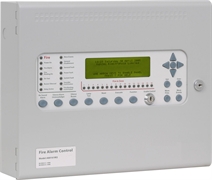 The operation and capability of EMS Group’s controllers with cause-and-effect functions will be familiar to anyone who uses conventional multi-loop analogue addressable systems. This allows the engineers current experience with traditional systems to be used as the basis for programming EMS wireless systems. All controllers can be fully networked.
The operation and capability of EMS Group’s controllers with cause-and-effect functions will be familiar to anyone who uses conventional multi-loop analogue addressable systems. This allows the engineers current experience with traditional systems to be used as the basis for programming EMS wireless systems. All controllers can be fully networked.
Radio Cluster Communicator (RCC): Each FireCell 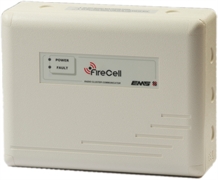 Radio Cluster Communictor or RCC has the capacity to support up to 31 wireless devices. (32 including the RCC itself) RCC's can be powered locally using a 240v dedicated fused spur or 24v. The RCC communicates directly to the radio hub, or via another RCC (up to 4 hops).
Radio Cluster Communictor or RCC has the capacity to support up to 31 wireless devices. (32 including the RCC itself) RCC's can be powered locally using a 240v dedicated fused spur or 24v. The RCC communicates directly to the radio hub, or via another RCC (up to 4 hops).
Wireless Sensors: EMS Group's range of analogue addressable fire sensors are based on industry standard devices. The sensors have no visible aerials and are low profile, aesthetically pleasing designs. Each device is powered by an alkaline battery pack.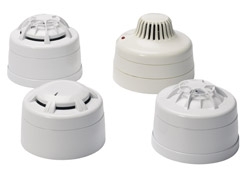
Providing reliable fire detection solutions for most applications the comprehensive sensor range includes:
- Optical smoke
- Heat
- Multi-Sensor (heat and smoke)
- Combined Sensor with Base Sounder or Voice Sounder
- Combined Sensor with Base Sounder or Voice Sounder and and LED Strobe
Wireless Callpoint: The model 5200 Radio callpoint is battery operated, incorporating a radio address module thereby eliminating the need for wiring back to the fire alarm control panel. 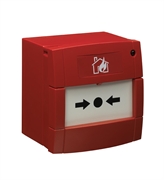 The callpoint is designed to meet BS5839 part 2. The callpoint is fitted into an industry-standard ABS moulding which allows for testing by insertion of a test key. When the glass is broken, the micro-switch is released, triggering an alarm transmission, by radio, to the alarm panel. Each unit has a unique address configured during manufacture and is individually addressable by the system controller during commissioning. The unit is programmed to report at regular intervals of 5 – 9 minutes.
The callpoint is designed to meet BS5839 part 2. The callpoint is fitted into an industry-standard ABS moulding which allows for testing by insertion of a test key. When the glass is broken, the micro-switch is released, triggering an alarm transmission, by radio, to the alarm panel. Each unit has a unique address configured during manufacture and is individually addressable by the system controller during commissioning. The unit is programmed to report at regular intervals of 5 – 9 minutes.
Wireless Sounders/Beacons: The sounders and beacons are powered by a low-voltage dual supply Alkaline battery pack. ![]() The battery pack condition is continually monitored. The battery board has been tested to provide up to 5 years of normal site operations. The system indicates remaining battery capacity and a low battery condition is indicated to the controller as a fault, leaving approximately 30 days for the battery pack to be changed.
The battery pack condition is continually monitored. The battery board has been tested to provide up to 5 years of normal site operations. The system indicates remaining battery capacity and a low battery condition is indicated to the controller as a fault, leaving approximately 30 days for the battery pack to be changed.
Wireless Input/Output Unit: The I/O unit is designed and manufactured using the latest techniques and surface mount technology ensuring component count is kept to a minimum, thereby maximising reliability. 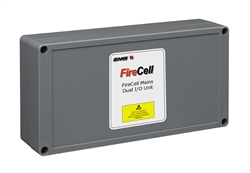 The I/O unit is powered by a low-voltage dual supply Alkaline battery pack. The battery pack condition is continually monitored. The battery board has been tested to provide up to 5 years of normal site operations. The system indicates remaining battery capacity and a low battery condition is indicated to the controller as a fault, leaving approximately 30 days for the battery pack to be changed.
The I/O unit is powered by a low-voltage dual supply Alkaline battery pack. The battery pack condition is continually monitored. The battery board has been tested to provide up to 5 years of normal site operations. The system indicates remaining battery capacity and a low battery condition is indicated to the controller as a fault, leaving approximately 30 days for the battery pack to be changed.

